Part 1. Here Comes Bigfoot
© Bruce G. MarcotThe tracks ... 12 inches, 14, 16 inches, longer ... are reported from many places throughout the world. Some people have made it their career -- as author, adventurer, or perhaps huckster -- to gather photos and plaster casts of some of the oddest tracks in nature.
Let's take a look at a few of these tracks and casts; these are mostly assumedly from the Northwest U.S. \1 Since these are not my own photos, I make absolutely no claim as to their authenticity. But, for the sake of argument, and to be fair, let's assume that the photographers were each earnest and presented in good faith what they believe are truly bigfoot tracks.
Here's one track taken in mud:
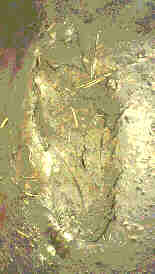
We'll get back to this, and others, later in the discourse.
Here's another, also in mud, that seems to show some backward sliding
of the foot in the slick substrate:
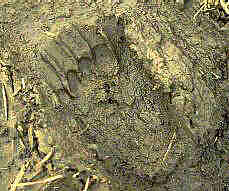
And here's another:
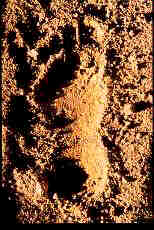
And here is a photos of a supposed bigfoot track cast:
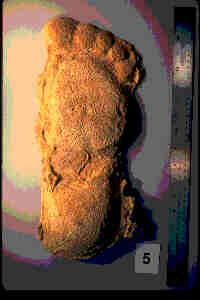
The above photo has a long metal ruler to the right, suggesting that
the track is about 14 inches in length (this shows up far better in the
original photo than in the version I post here).
I have one of my own to add here, and this will take just a little explanation.
In April 1998 I traveled to the State of Meghalaya in northeast India,
on assignment to help the Government of India with wildlife habitat conservation.
Several days into our difficult journey, we finally reached the remote
Garo Hills that rise abruptly from the vast plains of Bangladesh to the
south. For a week I lived with the Garo Hills Tribal people -- animists
turned part Christian over a century of visiting missionaries -- among their
bamboo mud and thatch hut villages. In the remote village of Baghmara,
my India biologist hosts (S.P. Singh and Ajai Saxena, to whom I am immensely
grateful) introduced me to a national park director A. Srivastava, who graciously
hosted us in his modest home along the Simsang River. There, he showed
me a plaster cast of some huge-appearing footprint.
He then told me the story. The Garo Hills Tribe have a legend
of "Forest Man" -- which in the Garo language is called "Matdngdng" (yes,
that's spelled correctly, and is pronounced "mut-ding-ding"). Matdngdng
is huge, and covered in dark dense hair. He is so big that he sleeps
standing up, leaning against the bole of a big tree. The cast that
our host had taken, now displayed on the floor of his home, was supposedly
of this huge but elusive
creature of Garo legend.
I photographed the specimen:
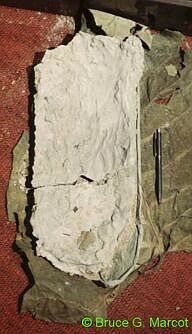
My pen to the right is 6 inches long.
Another local field research biologist working in that same Garo Hills area also told us the story of his finding a series of 9 similar tracks along a span of 3 kilometers (about 2 miles) along some distant riverbank. He said he followed the tracks a ways, and that its stride was 21 feet (yes, feet) and each track was 40 cm x 30 cm, or 16 inches long by 12 inches wide. The track length, at least, seems to pretty well match the size of other tracks and casts reported elsewhere.
With such similarity, might this be evidence of a race, perhaps many, of an unknown primate?
We'll come back to this intriguing story, and in particular the Matdngdng track, in a bit.
So what can be told from this brief survey of prints and casts? I myself have made many photos, sketches, and plaster casts of wildlife tracks ranging from cranes to grouse to raccoons to mountain lions ... and have tracked a wide variety of mammals including carnivores and even primates, and other animals, in North and South America, India, Asia, and elsewhere.
My experience tells me several things about making accurate casts and scientific measurements of tracks:
(1) Block out the casts.-- When you take casts, you should block out a rectangular area well beyond the edge of the impression itself, and fill the entire volume with plaster. Otherwise, you cannot tell if the shape of the cast was manipulated -- deliberately or inadvertently. Virtually none of the Bigfoot track casts I've ever seen have done this correctly.
(2) Align photos with scale.-- When photographing a track, at least some of the pictures should be take directly above the track to avoid problems with parallax and perspective (however, photographing a track series may necessitate taking the photo at a oblique angle to capture multiple tracks in one image). Also, something recognizable -- usually a pen or a ruler, with known length -- should be placed next to the track for scale.
(3) Inspect multiple tracks.-- One print tells you little.
You really need a sequence of tracks, because individual imprints can vary
quite widely, even from the same foot. It depends on the moistness
of the soil or mud, the stance of the animal, the slope and the relative
direction of travel, the speed the animal was traveling, and other factors.
Some individual tracks may not show all toes (this
is common with larger carnivores such as bears) or dewclaws (commonly missing
in most ungulate tracks), or the full foot pad (if the animal is resting
its weight more on the toes and forepart of the foot, which happens with
some big cats, bears, and others, and which varies by type and speed of gait). Other tracks in the same track
sequence might reveal details and lead you to a very different conclusion
about its maker.
(4) Take multiple measurements from each track.-- For mammal
tracks, you need to take multiple measurements at each imprint, be they from "live" tracks or
from plaster casts, including: overall length from the
hind edge of the pad to the front of the toes; length of just the pad;
overall width including the toe imprints; width of just the pad; and length,
width, and perhaps spacing of the individual toe imprints. Again,
none of the reports I have seen on bigfoot tracks or casts offers this kind
of information.
Also, you should inspect the variation in
the depth of the imprint. In most mammals, the arch of the pad and
the part of the foot between the pad and the toes should appear the least
deep in direct tracks (so the deepest in the "negative image" of a plaster
cast). I have seen photos of supposed bigfoot tracks that are uniform
in depth from heel to toe tips -- a sure sign of hoax. (But remember that variable depth
does not mean it is not a hoax.)
(5) Measure the stride.-- This includes the distance between
front and hind feet tracks on quadrupeds, and also front foot to front
foot stride (or hind foot to hind foot). This tells more about the
pace of the animal than it does the size (a typical misconception in bigfoot
track-hunters).
And measure this stride between as many consecutive tracks as possible, not just one set. Report the average and variation
in stride length. Few if any bigfoot track reports offer such data, at
least that I have seen.
Occasionally you hear reports of bigfoot strides (such as the stride of
the Matdngdng tracks reported by my researcher colleague in India) but
with no actual data presented or information on how it was determined,
other than measuring between only two tracks.
(6) Inspect the variation in pattern.-- Does the front foot always appear just behind the hind foot? Does this pattern vary? Are the tracks in a straight line with every 4th track slight offset, like foxes and other canids? Do they alternate from a line such as with the 3rd track offset, like some big cats? Do they regularly alternate back and forth from a line with individual tracks slightly pointing outwards, such as by us bipedal hominids?
(7) Report on the environment.-- This includes many things:
- the condition of the substrate -- wet mud, sand, friable soil, track partially
obscured by leaf litter, etc., which tells you how "impressionable" the
track would be
- the general habitat or vegetation type
- recent rainfall or precipitation, which may "melt" tracks to larger
sizes or make them unrecognizable
- recent warm days, to interpret tracks in snow, which may "grow" when
snow sublimates or melts, even if it refreezes
So what should we conclude here?
Reading "trail sign" such as tracks is truly a learned art. Many of the above guidelines can help impart a rigor to this skill, and surely some biologists are far more skilled in this art than am I. But the point to make here is that few if any reports on Bigfoot tracks have been scientific and thorough, as my guidelines above suggest. Even my field research biologist colleague of the Garo Hills of India failed to make, record, and report very accurate and thorough data on his sighting.
Remember, with incomplete evidence, identification can only be as incomplete.
Well, maybe we can be a little more conclusive that than. Which brings us to our next section:
Part 2. What Tracks Are These?
------------------------
\1 Note: I have taken the liberty of borrowing these photos from other web sites on Bigfoot. I surely do not intend to breach any copyrights, so I am using only photos that were not marked as copyrighted. To view them here in a reasonable manner, I have reduced their size, reduced the number of colors to 256, and sharpened details. To see a far wider array of such photos, just do a web search on "bigfoot" and stand back.